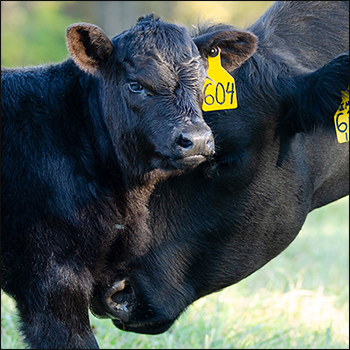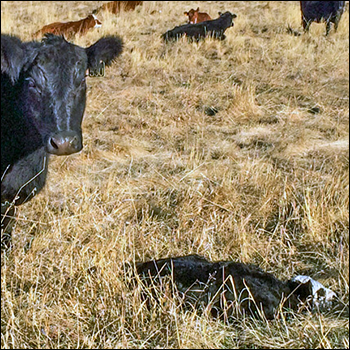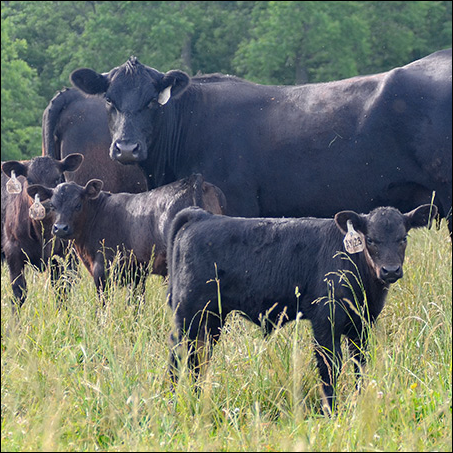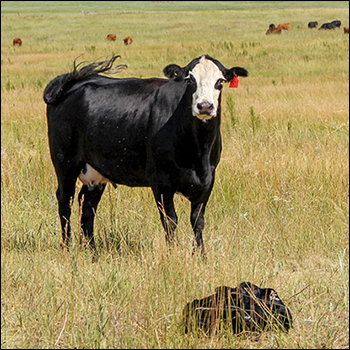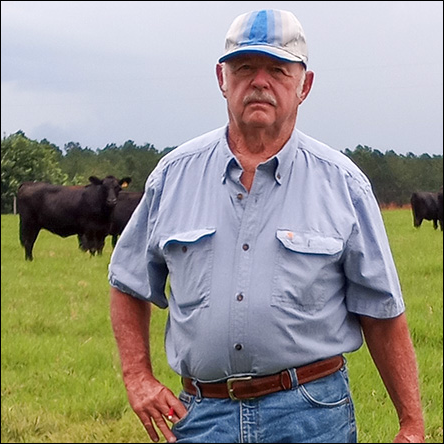Angus Advisor
Our team of Angus advisors offer regional tips for herd management for the summer season.
Southern Great Plains
david.lalman@okstate.eduMineral balance for the breeding herd
Grazing cattle generally benefit from a mineral supplementation program. Simple, right?
After all, a well-balanced, cost-effective program only requires knowledge of vitamins or vitamin precursors; availability; and the animals’ vitamin and mineral requirements for their current age, stage of production, and mineral status (abundant vs. depleted stores). With cattle’s tendency to be finicky and unpredictable in mineral supplement consumption, you have a situation one of my friends would refer to as “a conundrum causing great annoyance and displeasure.”
Chief among the sources of uncertainty is the dynamic nature of forage vitamin/mineral supply and the cows’ requirements — moving targets. Obviously, the mineral program does not need to produce precise balance each month, which is just about impossible to achieve.
A mineral balance exercise or audit should give you some confidence in your current program, or reveal an obvious need for a change. A mineral balance exercise involves developing a simple, consistent recordkeeping system to track forage mineral composition and your cow herd’s average or “normal” mineral consumption during the same time of year.
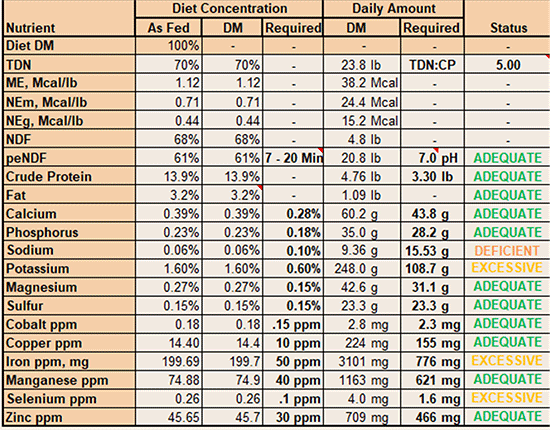
|
You can use a nutrition evaluation program to project deficiencies and/or excesses. You will need an idea of forage mineral concentration, an estimate of forage intake, a current estimate of average daily mineral supplement consumption and the mineral product’s composition from the label. Most beef cattle nutrition evaluation programs provide an estimate of forage intake and an estimate of daily mineral requirements based on weight and stage of production.
As an example, Figure 1 shows the nutritive balance table for 1,200-pound (lb.) lactating beef cows grazing lush spring tallgrass prairie forage and consuming 3.3 ounces (oz.) per day of a commercial mineral supplement. Status indicators in the right column show where major gaps or excesses exist.
In this example, these cows are projected to be about 7 grams (g) per day short of sodium. Since salt contains 40% sodium, this suggests these cows could use an additional 15 g of salt, or about 0.5 oz. per day.
There are several excesses identified in this example. Most mineral balance exercises in the Southern Great Plains are going to reveal excessive potassium and iron due to high forage concentration of both minerals. The other revelation in this balance exercise is the considerable excess of selenium.
Thus, the conclusion of this exercise is: this mineral supplement is a good complement to this forage source for this time of year; one could blend about 10%-15% salt with the mineral to better match sodium requirements with intake; selenium concentration in the commercial product could be reduced by about 50% if that were an option.
It most definitely points out there is no need to purchase mineral product containing a greater concentration of selenium.
Several commercial nutrition companies provide services to conduct balance exercises and recommend or manufacture customized mineral formulations. Commercial livestock nutrition laboratories have incorporated mineral composition analytical services. For example, our lab here at Oklahoma State University (OSU) charges $12 per sample to get macro- and microminerals.
Depending on your level of concern or interest, one might begin by conducting a winter feeding and summer grazing balance. A more ambitious approach might be to collect “hand-plucked” samples from one or more pastures each month. The idea of the hand-plucking method is to select only plants and parts of plants you believe your cattle are currently grazing.
For the example given above, I used the OSU Cowculator nutrition evaluation program. Similar programs are available through animal science departments at the University of Georgia (UGA Basic Balancer), Iowa State University (BRaNDS) and University of Arkansas (Mineral Profile Evaluator).
These are great tools to simplify this process. The feed library allows one to enter their own forage nutritive values and mineral supplement products/formulations. The “Balance” page provides guidance to estimate daily forage consumption and then a place to input the amount of mineral the cows are expected to consume.
Consider collecting forage mineral composition and mineral supplement consumption data several years in a row. Using that valuable information, you can get a good idea of how well your current program or product matches the forage resource to meet your cow herd’s needs.
Western Region
randyp@csufresno.eduFall–calving herds
Main Focus: cows are on cruise control
If precalving vaccinations such as a scours vaccine are going to be used, now is the time to decide on specific products.
Be sure cows are receiving adequate levels of calcium, phosphorus and trace minerals deficient in your area. Multimin® is an excellent injectable product, if that is a preferred route of administration. Copper and selenium boluses are effective means of delivering trace minerals over an extended period of time.
The target level of body condition at calving is a minimum body condition score (BCS) of 5.0 for mature cows and 6.0 for 2-year-old heifers on a scale of 1 to 9.
Midsummer is typically when fall-calving cows will maintain themselves adequately, with no need for either energy or protein supplementation as long as forage is available.
The developmental period from weaning to breeding time is critical for influencing the future productivity of females. Females should be developed to reach approximately 55% of their projected mature weight at the start of the breeding period.
Spring–calving herds
Main Focus: breeding season and suckling calf health
- 1. Depending on desired calving dates, the artificial insemination (AI) breeding period should be concluded. Monitor return heats and cleanup bull performance.
- 2. Be sure cows are receiving adequate levels of calcium, phosphorus and trace minerals deficient in your area. Consider chelated mineral products especially prior to calving and through the end of the breeding season. See the comments prior about injectable and bolus mineral products.
- 3. Energy balance has a major effect on fertility, and thus it is critical cows are in a state of positive energy balance or gaining weight during the breeding season. If cows are grazing irrigated pastures, they are usually fine in terms of being in a state of positive energy balance.
- 4. Treatment protocols and products should be on hand for scours and pneumonia in suckling calves. It is best to have two treatment options for both conditions and to be sure treatment protocols have been communicated to the appropriate personnel.
General management
- 1. If irrigated pastures are part of your forage resources, timely irrigation during hot summer months is critical in terms of affecting forage production. Midsummer is also an excellent time to control thistle or other invasive weeds in pastures.
- 2. Midsummer is the time when problems with pinkeye can become prevalent, and treatments can become very time-consuming. The incidence of pinkeye can be reduced by clipping tall, mature grasses and controlling flies with dust bags, pour-ons, fly tags and/or mineral products with fly-deterrent products included. In addition, availability of shade helps to reduce the incidence of pinkeye. It is important to treat problems quickly and aggressively, reducing the spread of the disease by flies.
- 3. Antibiotics such as the long-acting oxytetracyclines are effective in treating pinkeye. We have also had success with squirting 2 to 3 cc of Nuflor® directly into the infected eye. A more inexpensive treatment option (but more difficult to administer) is to treat the infected eye with an injection of 2 to 3 cc under the membrane that covers the upper portion of the eyeball with a mixture of 90% penicillin and 10% dexamethasone. We make up the mixture by buying a 100-milliiter (mL) bottle of penicillin, pulling out 10 mL of product and replacing it with 10 mL of dexamethasone.
- 4. Most people prefer to apply patches to infected eyes, and those can be made easily from old, worn-out jeans. Leave the bottom portion of the patch unglued so the eye can drain.
Southeast Region
jduggin@uga.eduOver the decades, Angus cattle have made a major maternal influence on the commercial cow-calf industry. The breed is now more widely known for growth performance and its significant effect on consumer satisfaction. We often ask cattle breeds to do everything, and that is a difficult balancing act.
Producers can help improve fertility in the herd by sticking to defined heifer selection protocols. Whether an operation wants to improve fertility or maintain a specific threshold, the following concepts from Pedro Fontes, UGA reproductive physiologist, should help accomplish those goals.
- 1. Body weight matters. Heifers should be 60%-65% of their mature body weight at the time of breeding. Keep in mind the mature body weight is not 1,200 lb. for a lot of our herds in the Southeast, where mature cow herd weights can average more than 1,400 lb.
- 2. Do not overcondition your heifers, as excessive body weight can lead to suboptimal fertility. A BCS of 6 is optimal prior to calving. During the breeding season, heifers should be in at least a BCS of 5 and gaining at least 1.75 lb. a day.
- 3. Work with your veterinarian to schedule prebreeding vaccinations. Recent research indicates vaccinating heifers too close to the beginning of the breeding season can decrease pregnancy rates.
- 4. Consider estrous synchronization and fixed-time AI. Increasing the percentage of heifers calving early will set the stage for lifelong productivity. Turn in bulls 14 days later to help differentiate breeding status (AI vs. natural service) at pregnancy diagnosis.
- 5. Schedule a pregnancy check no later than 90 days after AI. For a 60-day breeding season, producers can schedule a pregnancy check 30 days after bull removal. This will help the veterinarian to determine pregnancy status as well as AI vs. natural service pregnancies.
- 6. Consider keeping replacements that become pregnant in the beginning of the breeding season, preferably in the first 30 days. These heifers are adapted to your production conditions and can successfully perform from a fertility standpoint. Cull or sell the remainder. Early-bred heifers stand a better chance of breeding at 2 years old with their first calf at side, because they will have more time to recover and regain body condition.
Summary
Heifer development and breeding management are critical for long-term fertility. For those considering sexed semen, Fontes suggests use on heifers with an activated patch at breeding and conventional semen on other females. Although the number of calves of the desired sex may not be quite as high, the conception rates may be improved. For producers wanting to utilize sexed semen in all heifers, recently developed synchronization protocols specific to sexed semen are recommended.
Midwest Region
baileyeric@missouri.eduCow depreciation and the cow-calf business
The cow-calf business model is an asset-rich and cash-poor business. Lack of cash flow is a big factor in keeping younger generations from coming back. It takes a lot of assets to get the business off the ground, and the business has to be subsidized by off-farm income in the early years. Paying for land and cows is unrealistic with today’s prices.
What if there was a different way of looking at the business? To borrow a phrase from the influential Ranching for Profit, “What if we spent more time working ON the business than IN the business?”
Cow depreciation is the silent killer of cow-calf business models. In a nutshell, depreciation is the loss in value of a cow between purchase and sale. For example, you pay $1,800 for a fancy bred heifer, and she is culled as a nonpregnant 2-year-old. At sale, the open young cow is worth $800. She has depreciated by $1,000 in 10 months, and only produced one calf. After factoring in annual cow costs (pasture, feed, etc.), that cow did not generate a profit.
Here’s the chicken-or-the-egg question. Did you lose money on that heifer because she only produced one calf, or because you paid too much for her?
Many say it takes five to six calves for a cow to become profitable in the beef industry today. How many cows make it to that milestone?
Let’s start with 100 bred heifers. There are a couple of rough calf pulls or early calf deaths, and only 98 calve successfully. At preg check, 85% of the heifers are pregnant. Your herd is 84 bred 2-year-old cows.
Next year, 92% of the now-3-year-old cows calve. The herd is now 78 bred 3-year-old cows. Continue a 92% calving rate for the next three years and you will end up with 62 bred 6-year-old cows. I did not factor in any calf mortality or any cow death loss. Do the profitable 62 cows make enough to cover the losses incurred by the unprofitable 38 bred heifers from six years ago?
One of my guiding principles is growing cattle appreciate and mature cattle depreciate. I would rather put high-quality pasture forage through an animal that gains in value than to support the maintenance of a mature cow. Now, one could argue the cow is producing a growing calf, but you are paying for 12 months of feed for a mature cow to get eight months of growth off of the calf raised.
Think of it this way: if the cow consumes 12,000 lb. of forage per year (approximately 33 lb. of feed per day) and weans a 550-lb. calf, that is a feed conversion ratio of 22 lb. of feed per 1 lb. of calf gain! That’s three times more feed per pound of gain than in a stocker cattle model.
As I see it, there are two logical paths to reduce cow depreciation today. One is to buy cows already depreciated. This model works for some folks and makes a lot of sense, because we can make rapid genetic progress in the calves by mating to high-quality bulls. My biggest mental hurdle to this idea is the thought of buying someone else’s problems, and the variation in the quality of females purchased year over year.
The other path is a low-input heifer development system. This system requires a significant mindset shift. Historically, cattle producers have invested resources to maximize the chances of their preselected heifers getting pregnant. What if we kept most of the heifer crop and let our management system select breeding females? Another way of framing this discussion is around target weight. Historically, we have advocated producers develop heifers to 65% of mature cow weight at breeding. Reaching that threshold requires additional feed inputs beyond pasture forage.
I like a system where we invest little in developing the heifers, finding out who breeds despite our management, then invest feed resources in the bred heifers. The target weight that matters is having the heifers weigh 85%-90% of mature weight at calving, which lessens the risk of calving problems. Any heifer that does not breed is marketed as a feeder heifer. Weight gained between weaning and breeding is additional revenue for the farm.
There are structural changes needed for this to be successful. You may have to reduce the number of mature cows to have enough forage to run your heifer development program in a stocker model. You have to move past selecting replacement females at weaning, and look past conception rates historically deemed unacceptable (50%-60%). There’s profit in open females, so long as they gain weight from weaning to breeding.
Reducing cow depreciation is one of several methods to increase profit without increasing costs. I am passionate about advocating for growing cattle enterprises across the United States because of the potential revenue generated. A low-input heifer development system is the best of both worlds.
The best part of growing cattle systems is that cattle are easily marketed in times of drought. You have less emotional investment in them and are less likely to feed them through a drought. I always say, “The best cattlemen do not make the most money in the good years. They lose the least money in the bad years.”

